AuthorFor the second round, Mello-La Rovere replaced the Salomão partnership, while Barbosa-Rodrigues came in replacing Brenner-Villas Boas. Both North-South pairs stayed the same.
0 Comments
AuthorThe Brazilian Trials for the selection of the team that will represent Brazil in the next World Championship (Salsomaggiore, Italy, in August 2020) were disputed between January 18th and 25th. The team of Roberto BARBOSA, Adriano Rodrigues, Diego Brenner, Miguel Villas Boas, Marcelo Branco & Gabriel Chagas won the final match against the team of Jeovani SALOMÃO, Henrique Salomão (only 19 years old!), João Paulo Campos, Stefano Tommasini, Roberto Mello & Emilio La Rovere. Let us follow the hands in the 84-board final (divided in 6 stanzas of 14 boards each). In this first round, JP Campos and S Tommasini were in the Open Room, in North-South, facing D Brenner and M Villas-Boas. In the Closed Room, G Chagas and M Branco, in North-South, tackled H Salomão - J. Salomão. Board 1 was an interesting push: In the Open Room, JP opened the North hand. I would have opened it too. After 1 Club - 1 Spade, though, he had an uncomfortable rebid problem, and picked 2 Clubs. Now Stefano had a decision to make, and he decided in favor of aggressiveness, bidding 3 Hearts, showing invitational values and 5-5. It worked out well in the end when North raised to the easy 4 Hearts. Note how it is easy because of the fitting club honors (no doubt this was a major factor behind South's decision to push). In the Closed Room, Chagas, perhaps foreseeing rebid problems, preferred to pass as opener. Jeovani Salomão opened the East hand with a 12-14 NT. This actually simplified the bidding for N-S when South, Branco, had a bid that depicted a major two-suiter. He bid 2 Clubs, West bid 2 Diamonds, and North ended the auction by jumping to game in hearts. Different roads, same landing spot, no imps exchanged. In the Open Room, Miguel and Diego went overboard when East opened a 12-14 NT. Especially at this vulnerability, I think this is a very good choice of opening bid, but the hands fitted badly when Diego could not deliver a 2nd club. They landed in 3NT and went down 3 when South hit on a spade lead, attacking declarer's entries to the long clubs. Miguel made the expected misguess in clubs -- if clubs are 3-3, it is a straight guess, but if they are 4-2 with South having the doubleton, playing the Queen picks up the suit if South has Jx, while playing the 10 does not pick up the suit in the symmetrical situation of Kx in South. Without being able to bring the clubs home, the contract was hopeless. In the closed room, E-W stopped low, after 1 Club by East, 1 Diamond (=Hearts) by West, 2 Clubs by East, and a well-judged pass by West. (Note how the singleton in partner's long suit influenced his choice). SALOMÃO might win 6 imps (-150 in one room, + 90 in the other), but North-South found the best defense of a heart lead and the diamond Queen return. Try as he might (even if he guessed clubs right!), declarer would lose 2 diamonds, 2 hearts, and 2 clubs. Still, it was good enough for 3 imps (-150 vs. -50), tying the match, since BARBOSA started with a 3 imp carryover. You are in second position, Vul against Not. Do you open this hand? Diego did, Henrique Salomão did not. Score one for light opening bids -- the opponents reached 3NT in both tables, but the diamond lead ended declarer chances. 10 imps to BARBOSA. The spotlight was on the same players in the next board. Your right-hand opponent starts with 1NT (15-17). They bid to 4 Hearts, showing a 4-4 fit after a Stayman-like auction. What do you lead? In one table, dummy showed both majors. Does it influence your lead? Both leaders went with the in-your-face lead of the Ace of Diamonds, but this not only helped declarer establish his 5-card (!) diamond suit, but also helped him guess spades (he had an Ace-Queen guess there, and played you to not have the Ace, once you showed AK of diamonds). A club lead would have made him work harder. The hand can always make, though. It goes to show something. Or perhaps nothing at all. SALOMÃO gained 4 imps in the next board when they stopped safely in a part-score while Miguel-Diego bid a hopeless (as the cards were) nonvulnerable 3NT, going down one. Board 6 was another interesting push: In the Closed Room, West, Henrique, opened a 12-14 NT, which shut North up. They were allowed to play in 3 Hearts after a transfer auction, making an overtrick. In the Open Room, Diego opened 1 Club. JP overcalled 1 Diamond, with his hefty diamonds. East-West had the right tool for this hand -- East's double of 1 Diamond showed 5+ Hearts. When South jump raised his partner to 3 Diamonds, East could bid 3 Hearts, being assured of 8 cards in the fit. 3 Hearts might go down in some other day, but as the cards were -- and particularly since the possible spade trick for the defense could not be established by direct leads -- 9 tricks were taken here, too. West in the hot seat again. All vul, 2nd-in-hand. Do you or don't you open? Being consistent with Bd. 3, Diego opened, and Henrique passed. The board was passed out in the Closed Room. The Open Room ended in 1NT, and made only 6 tricks (it might have been 5). 3 imps to SALOMÃO. Score one for sound openings. West again has the problem, but this is a systemic victory for BARBOSA, rather than a judgment one. Diego had available a 2 Hearts opening showing hearts and a minor suit. Henrique didn't -- so, he passed, heard his partner open a 12-14 1NT, and South doubled. The partnership was no longer in "game searching mode" by then, so they stopped in 3 Hearts (over 2 Spades by the opponents). At Diego-Miguel's table, the hand was quickly bid to 4 Hearts, which was made with a successful (and indicated) trump handling. 6 imps to BARBOSA. The score was BARBOSA 19 x 10 SALOMÃO at this point. After a push in a well-bid 4 Hearts, the spotlight turned on South, for a change. Stefano and Marcelo had to lead against 3NT. Stefano heard a Gazzilli auction in which declarer, having opened 1 Heart, showed 15+ hcp and either a balanced hand with 3 spades or a 5431 (unknown suits besides the 5 hearts). Dummy showed long diamonds and 8+ hcp. He led a spade. Marcelo heard a 1 Heart opening too, but then declarer showed a non-descript game forcing hand (denying 55 or other extreme shapes), and responder broke a relay chain to show long diamonds, upon which opener picked 3NT as the final contract. He led a club. The spade lead gave nothing away (the opponents had AQxx opposite KJ10), but the club lead cost a trick (it ran to declarer's AK109). 12 fat imps to SALOMÃO. West had to hog all the attention again in the next board. Both players heard the same bidding: LHO opened, third-in-hand, with 1 Diamond. Partner passed, RHO bid 1 Heart, and they passed again. LHO then bid 3 Spades, a heart raise with shortness in spades, and RHO ended the bidding with 4 Hearts. What is your lead?
Diego tried a club, the unbid suit. Henrique led a diamond. The club lead gave up a trick and a tempo (dummy had AKxx, declarer let it run to his J9x), the diamond lead gave nothing away (partner has AJ9x, dummy had K10xx). 10 imps to SALOMÃO, which had gained 22 imps in consecutive boards after two ineffective leads by BARBOSA. The score was now SALOMÃO 32 x 19 BARBOSA. The next board was a possible slam (requiring only one loser, combined, in these two suits: AKJxx opposite xxx, and AJ7xx opposite K10xx), but no team got close. Stefano and João Paulo had to face more preemption and landed in 5 Diamonds (the 9-card fit). Gabriel and Marcelo had less obstruction to deal with, and stopped in 4 Hearts, but Marcelo misguessed the play and made 10 tricks, to get a pushed board. The last 2 boards of the round were not recorded by the Vugraph. BARBOSA gained one imp in them, and so the round ended with SALOMÃO 12 imps ahead, 32x20. AuthorIn any given bridge hand, the likelihood that the opening lead will be the most important card played is very high. More contracts are won (or lost) on the opening lead than on any other card. You will never be able to reach your highest bridge aspirations if you do not devote some study to the improvement of your opening leads. While defense is said to be the hardest part of bridge, the opening lead is the hardest part of the defense. But this does not mean that the opening lead is a matter of chance. Quite the opposite: the expert makes the "killing lead" more often than the average player. There are some principles that help the expert when they are picking the opening lead, which can be employed profitably by all players. Above all, we must pay attention to the auction before leading. Perhaps the biggest difference between the expert and the average player in this department is that the expert chooses his lead taking the bidding into account, while the average player looks for the "table of opening leads" (AK, KQ, singletons, etc.) and picks his lead according to that table. There is nothing wrong with that -- the expert, other things being equal, also follows this routine. The problem is that the other things are very seldom equal! Let us examine a simple example of this idea: After this bidding, if you gave this hand to a panel of experts, the heart lead would be close to unanimous. The bidding did not give us any clue to pick between spades and hearts, and the heart suit is safer (thanks to that 9). If the opponents have A10x in the dummy and Kxx in hand, both leads are bad, giving up a trick that declarer would not make by himself; but if these cards are inverted, the 9 of Hearts is still guarding your Jack. A slight modification already produces a startling effect: With the same auction, you would probably see some controversy in this second hand. Some experts would lead diamonds (the best suit), for the same reasons presented above, but many others would lead hearts. Why? Because the red suits are not equivalent in this auction, unlike the major suits of the previous example. If dummy had 5 hearts, he would almost always bid the suit (by a transfer). If there were 4 hearts there, he would often have explored the possibility of a 4-4 fit (through the use of Stayman). In other words, the 1NT-3NT auction, in most cases, denies 4+ cards in a major (in dummy). And these inferences are not applicable to the diamond suit -- dummy can have 4, 5, or even 6 cards there. We see here how the inferences from the bidding -- including not only the bids that were made, but also the bids that were not made -- can influence the choice of opening lead. If the red suits were identical (either with or without the 9), you would see a very clear majority of experts leading hearts, for objective reasons. In our actual example, with diamonds a bit stronger, the opening lead is not so clearcut. (It is worth pointing out that top partnerships are aware, and have been for many years, of this inferences from the bidding when they are responding to 1NT, and thus avoid Stayman, or even using a transfer, in hands that "look a lot like NT". The more "automatic" is the investigation of a possible major suit fit from dummy in the opponents' partnership, the more indicated is the major suit lead against an auction such as 1NT-3NT). Let us take a look at how this can impact the decision of great players in a real hand. In 1979, the Reisinger ended in a tie, and there was a tie-breaker round of 12 boards between the two leading teams. On the 5th hand of this tie-breaker, the East players had to lead against 3NT from:  What is your lead? You already know that the question is incomplete. You have to ask what was the bidding! At one table, the auction went like this: 1NT by RHO, you passed, 2 Diamonds (Forcing Stayman, not a transfer) from LHO, pass from partner, 2NT from RHO, denying a 4-card major suit (are you thinking about your lead?), you passed, 3NT from dummy, all passed. And now, what is your lead? Dummy showed some interest in the major suits (else he would have just bid 3NT directly). Declarer doesn't have a major suit of 4+cards. Dummy had the entire 3-level to investigate a possible problem in 3NT, but decided against it. So, dummy is not really concerned about opener having a low doubleton, or three small cards, in a major. Taking all of these clues in, Bobby Levin led from his strongest suit, a low club. Let us go to the other room now. The auction there went like this: 1NT from RHO, you passed, 2 Hearts (transfer) from LHO, partner passed, 2 Spades from RHO, you passed, 3NT from LHO, all passed. Ira Rubin had these cards. From his viewpoint, dummy probably did not have 4 hearts (he would have preferred Stayman with 54 in the majors). Declarer may have 4 hearts, but he may also have 4 diamonds, or 4 clubs, and it is rather more likely that he will have 5 (or more!) clubs or diamonds, than hearts. In other words, by the pure "count of cards in each suit", it is more likely that hearts are the combined longest suit for the defense. And so he led a small heart. This was the full hand: Note how both leaders were correct in the inferences available in each auction. Nevertheless, one of them hit on the killing heart lead, while the other lost a trick in the opening lead. As usual, the opening lead was the most important card. Let us now end this article with the analysis of a brilliant lead, from Gabriel Chagas, which decided a South American championship against Venezuela, some 40 years ago. Chagas had something like the following hand, and this was the auction: 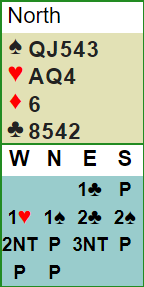 Chagas reasoned as follows: Declarer clearly has a spade stopper, or two. Dummy is hoping to make the contract by running clubs. And North's club holding is ominous for the defense. The odds that the clubs will run (or perhaps that partner has a stiff honor which will be soon revealed -- something like KJ10xxx and Ax with the opponents) must be huge. This means that, for the spade lead to be the best, partner must have a spade honor and a club stopper; if he does not have that club stopper, declarer will probably be able to run 9 tricks before the defense can do anything else, even if the spade suit is established in the opening lead. The entry in hearts will be too late to break the contract. On the other hand, the opponents did not try to find a heart fit. Support doubles were not in vogue back then, so dummy would probably make an effort to reveal 3 cards in hearts, whether by supporting directly at his second bid, or, almost certainly, by bidding 3 Hearts over 2NT. That means that the hearts are most likely 4-2 (or perhaps even 4-1) with the opponents. So, there is a fair chance that partner has a good holding in hearts; but, more crucially, even if the heart lead is not so good for the defense, if partner has that winning case for the spade lead (a spade honor and a club stopper), North can still switch to spades after leading the heart Ace! Depending on the sight of dummy and on the card that his partner (P.P. Assumpção) would play, he could decide how to direct the defense. Look at it in this way: the heart lead would only be disastrous if the heart King were the 9th trick in a hand where partner has a spade honor and a club stopper, but in which declarer no longer needed to establish clubs after that heart lead. Try to concoct such a hand. It is not easy. The hand has a happy ending for us, Brazilians, for this was the entire hand: Chagas had read the hand perfectly, and the defense cashed 4 hearts and 1 spade. The spade lead does not give up the hand -- Assumpção could switch to hearts. Would you? With Jx of hearts in dummy, K108x in your hand, and declarer having bid hearts? Is it not more likely that your partner will have the club stopper (the Ace), in which case you have to continue the spade attack, rather than breaching a new suit (bid by declarer, to boot)? Congratulations to Chagas for making partner's life easy with a great lead (which might have worked in different scenarios -- e.g., Kxx K10xxx xxxx x with partner, and a singleton Jack of hearts in dummy),
The bottom line: before making the opening lead, make an effort to visualize, as much as possible, the opponents' distribution and your partner's. Every auction is full of clues! And don't forget to do this while the auction is taking place -- otherwise your lead will take a long time to show up at the table (and remember that declarer is paying attention too... taking too long for a lead is a clue for him as well). |
Archives
September 2021
Categories
All
|


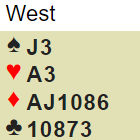
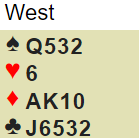

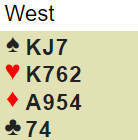




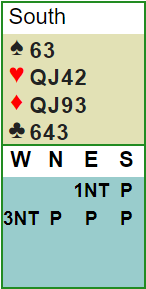

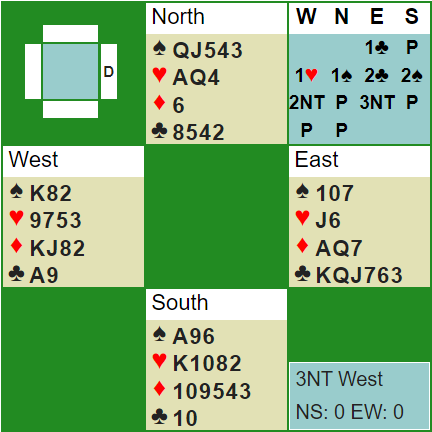
 RSS Feed
RSS Feed